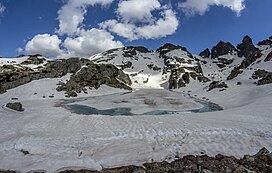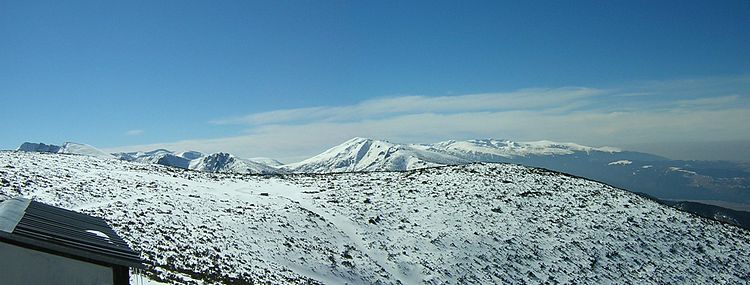Rila
| Rila | |
|---|---|
| Template:Lang-bg | |
 The Dreadful Lake | |
| Highest point | |
| Peak | Musala |
| Elevation | 2,925 m (9,596 ft) |
| Dimensions | |
| Area | 2,629 km2 (1,015 sq mi) |
| Geography | |
 | |
| Country | Bulgaria |
| Geology | |
| Rock type(s) | granite, gneiss, marble, quartz |
Rila (Template:Lang-bg, pronounced [ˈriɫɐ]) is a mountain range in southwestern Bulgaria and the highest mountain range of Bulgaria and the Balkans, with its highest peak being Musala at 2,925 m. The massif is also the sixth highest mountain in Europe (when each mountain is represented by its highest peak only), coming after the Caucasus, the Alps, Sierra Nevada, the Pyrenees and Mount Etna, and the highest between the Alps and the Caucasus. More than one-third of the mountain is occupied by the Rila National Park, the rest lies within the Rila Monastery Nature Park.
The name Rila is believed to be of Thracian origin and is thought to mean "well-watered mountain", owing to Rila's abundance of glacial lakes (about 200) and hot springs in fault areas at the base of the mountain. Some of the Balkans' longest and deepest rivers originate from Rila, including Maritsa, Iskar and Mesta.
Culturally, Rila is famous for the Rila Monastery, Bulgaria's largest and most important monastery, founded in the 10th century by Saint John of Rila. Alongside the cultural landmarks the mountain is also famous for the Seven Rila Lakes.
Geology
Rila is a dome-shaped horst mountain, part of the Balkans' oldest land, the Macedono-Thracian Massif. It was formed by granite and gneiss rocks and crystal schists during the Paleozoic (250,000,000 years ago). Rila's alpine relief was formed during the Pleistocene by a series of glacial periods. During the most recent, so-called Würm glaciation, 10-12,000 years ago the permanent snow line was at 2,100 m above sea level. Above this line glaciers radically changed the existing relief, carving out deep cirques, sharp pyramid-shaped peaks, rock pinnacles, various valleys, moraines and other typical glacial formations.
Borders and climate
Rila has an area of 2,400 km². The dome of the mountain rises over the surrounding mountain valleys, with the Borovets Saddle (1,305 m) connecting the main Musala Ridge with the Shipochan and Shumnatitsa ridges that connect to the Ihtiman Sredna Gora mountains through the Gate of Trajan pass. The Yundola Saddle (1,375 m) and the Avramovo Saddle (1,295 m) link Rila with the Rhodopes to the east, while the connection with Pirin is the Predel Saddle (1,140 m), the one with Verila being the Klisura Saddle (1,025 m).
The climate is typically alpine, with 2,000 mm of precipitation on Musala yearly, about half of which is snow. The lowest average temperature ever measured in February on Musala is –11.6 °C and the absolute minimum is -31.2 °C. An average temperature for August is 5.4 °C, the maximum being 18.7 °C.

| Climate data for Musala Peak | |||||||||||||
|---|---|---|---|---|---|---|---|---|---|---|---|---|---|
| Month | Jan | Feb | Mar | Apr | May | Jun | Jul | Aug | Sep | Oct | Nov | Dec | Year |
| Record high °C (°F) | 7 (45) |
3.4 (38.1) |
12.1 (53.8) |
13.7 (56.7) |
12.6 (54.7) |
16.5 (61.7) |
20.0 (68.0) |
18.7 (65.7) |
17 (63) |
14 (57) |
9.6 (49.3) |
6.8 (44.2) |
18.7 (65.7) |
| Mean daily maximum °C (°F) | −8.2 (17.2) |
−7.6 (18.3) |
−5.6 (21.9) |
−1.6 (29.1) |
2.5 (36.5) |
7.0 (44.6) |
10.0 (50.0) |
10.2 (50.4) |
6.1 (43.0) |
1.8 (35.2) |
−2.1 (28.2) |
−6.1 (21.0) |
0.5 (32.9) |
| Daily mean °C (°F) | −10.9 (12.4) |
−10.8 (12.6) |
−9.0 (15.8) |
−5.2 (22.6) |
−1.0 (30.2) |
4.3 (39.7) |
6.8 (44.2) |
7.1 (44.8) |
2.6 (36.7) |
−1.0 (30.2) |
−4.9 (23.2) |
−8.6 (16.5) |
−2.5 (27.5) |
| Mean daily minimum °C (°F) | −13.8 (7.2) |
−13.6 (7.5) |
−11.6 (11.1) |
−7.8 (18.0) |
−3.4 (25.9) |
1.5 (34.7) |
3.6 (38.5) |
4.1 (39.4) |
0.2 (32.4) |
−3.6 (25.5) |
−7.3 (18.9) |
−11.0 (12.2) |
−5.2 (22.6) |
| Record low °C (°F) | −30.6 (−23.1) |
−29.8 (−21.6) |
−26.8 (−16.2) |
−20.6 (−5.1) |
−15.6 (3.9) |
−12 (10) |
−8 (18) |
−9.8 (14.4) |
−14 (7) |
−17.5 (0.5) |
−27.4 (−17.3) |
−31.2 (−24.2) |
−31.2 (−24.2) |
| Average precipitation mm (inches) | 126 (5.0) |
110 (4.3) |
130 (5.1) |
128 (5.0) |
119 (4.7) |
105 (4.1) |
80 (3.1) |
56 (2.2) |
47 (1.9) |
72 (2.8) |
88 (3.5) |
115 (4.5) |
1,176 (46.3) |
| Average rainy days | 1 | 0 | 0 | 0 | 4 | 8 | 9 | 7 | 6 | 3 | 1 | 0 | 39 |
| Average snowy days | 13 | 14 | 17 | 18 | 14 | 5 | 2 | 1 | 4 | 8 | 13 | 15 | 124 |
| Mean monthly sunshine hours | 114 | 112 | 140 | 127 | 168 | 181 | 250 | 250 | 182 | 169 | 128 | 104 | 1,925 |
| Source: Stringmeteo.com | |||||||||||||
Flora & Fauna
The flora of Rila contains three local endemics which are seen only in this mountain. These plants are Primula deorum (with the largest population), Rheum rhaponticum and Alchemilla pawlowskii. In the mountain thrives also 36 plants as Campanula lanata, Centaurea mannagettae which are endemic for the Balkans. Some of the plant species have survived the last glacial period by turning into relict organisms.
Some of the animals, which live in Rila, are in danger as well. 24 of the species that inhabit Rila are listed in the IUCN Red List of Threatened Species.[1] There are 172 types of vertebrates living in Rila and 121 of them are registered in the Bulgarian Red List of Threatened Species, 15 are recorded in the European Red List of Threatened Species, 24 are listed in the International Union for Conservation of Nature and 158 of 172 are included in the Bern Convention lists.[2] Such animals are Barbus cyclolepis (which is rare because of the habitat loss and the river pollution), Triturus alpestris, Spermophilus citellus (European Ground Squirrel) and others.
List of mammals in National park Rila


There are 48 mammal species in National park Rila
Insectivores
• Shrew
Bats
• Bats
Lagomorphs
Rodents
• Vole
Carnivores
• Red fox
• Marten
• Wild cat
Even-toed ungulates
• Roe deer
• Red deer
Subdivision





Rila is subdivided into several parts depending on their geographic position.
- East Rila or the Musala Ridge is the highest and vastest part. The highest peak, as well as 12 of the 18 peaks over 2,700 m are located there — Musala, Yastrebets, Irechek, Deno Mancho, etc. The Musala Lakes lie in this part of Rila, as well as Ledeno ezero ("Icy Lake"), the highest lake of the Balkans at 2,709 m. Other lakes in East Rila include the Maritsa Lakes and the Ropalitsa Lakes. The renowned mountain resort of Borovets is also located in this part of the mountain.
- Central Rila or the Skakavets Ridge is the smallest part (1/10 of the total area), most famous for the glacial lakes — the Fish Lakes, Dzhendem Lakes, Monastery Lakes. The largest glacial lake of the Balkans, Smradlivo ezero ("Stinky Lake") with an area of 21.2 km² is located in Central Rila, as well as the peaks Kanarata, Cherna polyana, Malak Skakavets and Golyam Skakavets, Rilets. The ridge of the Skakavtsi (the peaks of Golyam Skakavets and Malak Skakavets, Pchelina and Sveti Duh) rises isolated between the Levi and Beli Iskar rivers. Another well-known ridge in the area is the one of Marinkovitsa and Vodniya chal, extending to the forest reserve of Kobilino branishte.
- Northwest Rila takes up 25% of Rila's total area. The highest peak is Golyam Kupen at 2,731 m. The Seven Rila Lakes are an important landmark in this part, as well as the many remote peaks and small lakes.
- Southwest Rila or the Kapatnik Ridge occupies 30% of Rila and has the oldest reserve of Bulgaria. Apart from its small northern part, Southwest Rila does not have the alpine appearance of the other parts.
Peaks in Rila
- Musala — 2,925 m
- Malka Musala (Lower Musala) — 2,902 m
- Ovcharets (Yurushki chal) — 2,768 m
- Golyam Kupen — 2,731 m
- Malyovitsa — 2,729 m
- Popova kapa — 2,704 m
- Malka Malyovitsa — 2,698 m
- Lopushki vrah — 2,698 m
- Lovnitsa — 2,695 m
- Kanarata — 2,691 m
- Orlovets — 2,685 m
- Pastri slap (Aladzha slap) – 2,684 m
- Zliya zab — 2,678 m
- Eleni vrah — 2,654 m
- Kovach (Nalbant) vrah - 2,640 m
- Suha Vapa vrah - 2,638 m
- Ravni vrah (Ravni chal) — 2,637 m
- Belmeken — 2,627 m
- Kamilata — 2,621 m
- Golyam Mechi vrah — 2,618 m
- Dvuglav — 2,605 m
- Golyam Mramorets (Golyam Mermer) — 2,598 m
- Dodov (Drushlevishki) vrah — 2,597 m
- Kozi vrah — 2,587 m
- Iglata — 2,575 m
- Mechit — 2,568 m
- Ushite — 2,560 m
- Ptichi vrah (Ashiklar) — 2,536 m
- Malak Mechit — 2,535 m
- Yanchov vrah — 2,481 m
- Malak Mechi vrah — 2,474 m
- Strazhnik (Kurdzhilak) — 2,469 m
- Budachki kamak — 2,447 m
- Kukov vrah — 2,411 m
- Tsarev vrah — 2,376 m
- Ivan Vazov (Damga) — 2,342 m
- Markov kamak (Gorna Kadiitsa) — 2,342 m
- Malka Popova kapa — 2,180 m
- Treshtenik — 2,020 m
- Angelov vrah
- Malak Lopushki vrah
- Malak Mramorets (Malak Mermer)
Trivia
Rila Point on Livingston Island in the South Shetland Islands, Antarctica is named after Rila Mountain.


